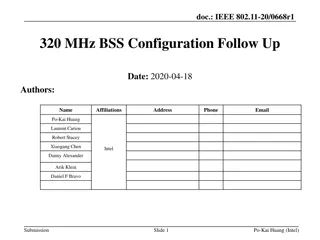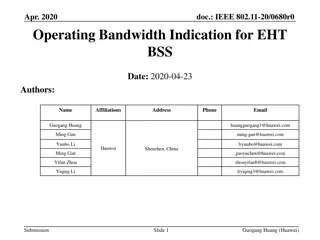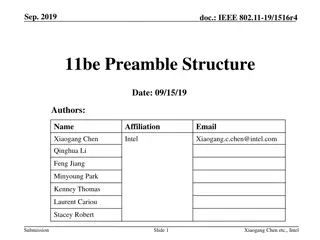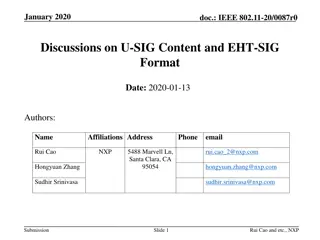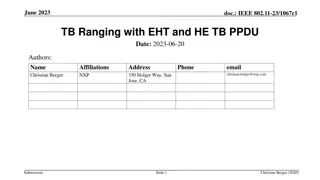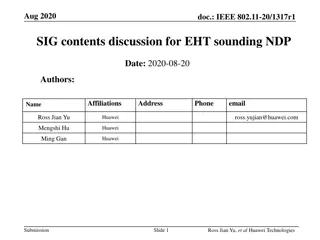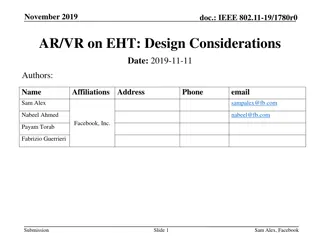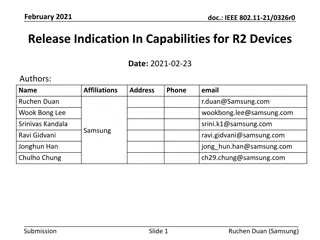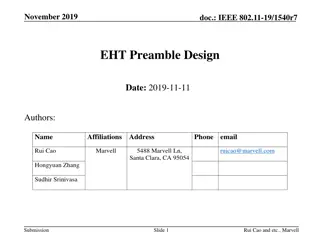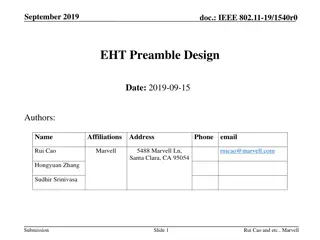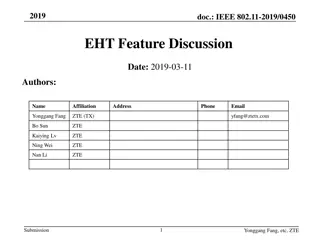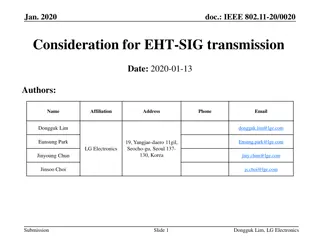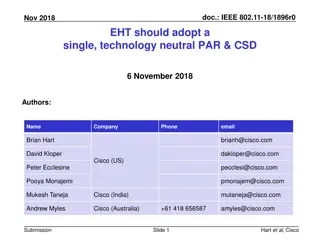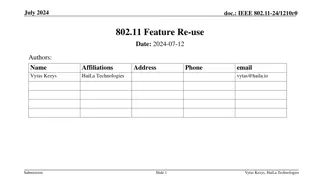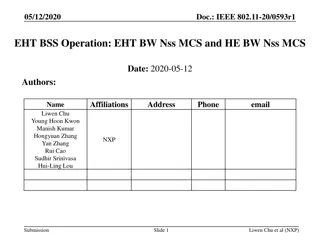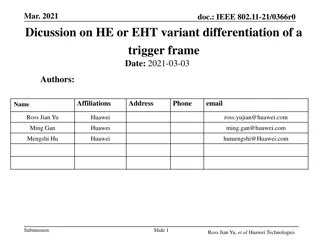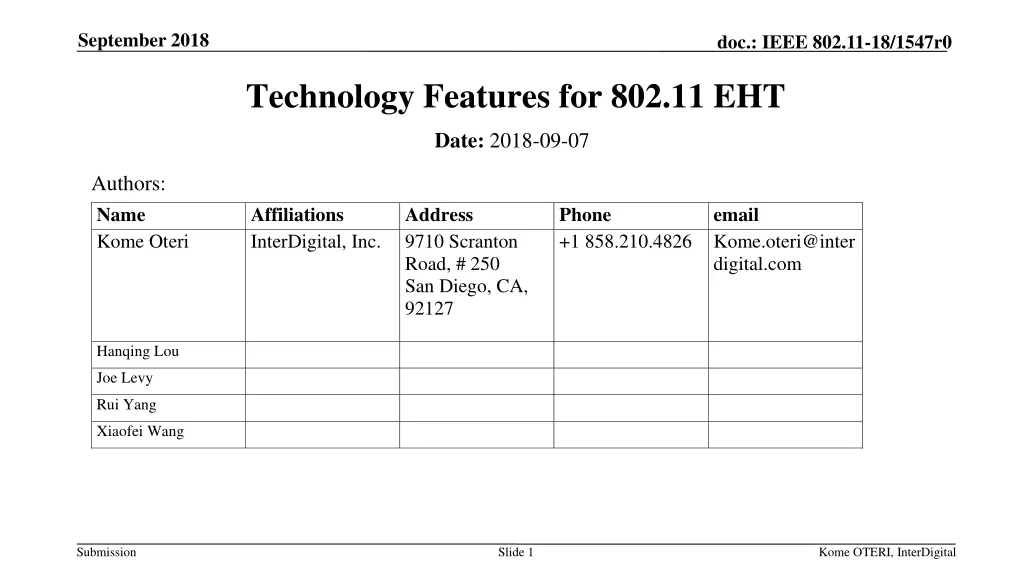
IEEE 802.11 EHT Technology Features and Enhancements
Delve into the world of IEEE 802.11 EHT technology as it aims to revolutionize peak throughput, efficiency, and latency for high-demand applications like video-over-WLAN, gaming, AR, and VR. Explore key technologies, schemes, and potential issues that the EHT study group is addressing towards rapid standardization.
Download Presentation

Please find below an Image/Link to download the presentation.
The content on the website is provided AS IS for your information and personal use only. It may not be sold, licensed, or shared on other websites without obtaining consent from the author. If you encounter any issues during the download, it is possible that the publisher has removed the file from their server.
You are allowed to download the files provided on this website for personal or commercial use, subject to the condition that they are used lawfully. All files are the property of their respective owners.
The content on the website is provided AS IS for your information and personal use only. It may not be sold, licensed, or shared on other websites without obtaining consent from the author.
E N D
Presentation Transcript
September 2018 doc.: IEEE 802.11-18/1547r0 Technology Features for 802.11 EHT Date: 2018-09-07 Authors: Name Kome Oteri Affiliations InterDigital, Inc. Address 9710 Scranton Road, # 250 San Diego, CA, 92127 Phone +1 858.210.4826 Kome.oteri@inter email digital.com Hanqing Lou Joe Levy Rui Yang Xiaofei Wang Submission Slide 1 Kome OTERI, InterDigital
September 2018 doc.: IEEE 802.11-18/1547r0 Abstract 802.11 has agreed to start an Extremely High Throughput (EHT) Study Group with the objectives [1]: to increase peak throughput and improve efficiency to support high throughput and low latency applications such as video-over-WLAN, gaming, AR and VR In this contribution we, review different technologies; examine how they achieve the goals of the SG; highlight schemes within the technologies that may be studied and identify issues that may need to be resolved. Submission Slide 2 Kome OTERI, InterDigital
September 2018 doc.: IEEE 802.11-18/1547r0 Technologies In the discussion leading to the formation of the SG, a variety of technologies were proposed with a goal to down-select to a manageable subset for rapid standardization. To achieve the goals of peak throughput, efficiency improvement and reduced latency for high throughput applications, EHT should consider supporting the following technologies: MIMO Enhancement, Multi-AP transmissions, Multi-band/Multi-channel aggregation, Hybrid ARQ, Increased Bandwidth Transmission (320 MHz) Submission Slide 3 Kome OTERI, InterDigital
September 2018 doc.: IEEE 802.11-18/1547r0 MIMO Enhancements 11ax allows for up to 8 SS. EHT should support up to 16 SS to increase peak throughput [2], [3], [4]. Potential Schemes Zero Forcing [3] Non-linear Precoding, e.g., Tomlinson-Harashima Precoding [6] Some issues to be resolved: Feedback Overhead Reduction Feedback Compression [5] Use of reciprocity [2] Protocol modification [2] Efficient MU-MIMO procedures Submission Slide 4 Kome OTERI, InterDigital
September 2018 doc.: IEEE 802.11-18/1547r0 Multi-AP Transmission 11ax supports transmission to/from a single AP and spatial sharing between APs/STAs. EHT should extend support to multi-AP transmission for improvement in efficiency, increase in peak throughput and reduce latency [7], [8], [9], [10]. Potential Schemes Dynamic AP selection Spatial or scheduling coordination for multiple AP transmission [10]. Joint Precoding with Multiple APs [7], [8] Some issues to be resolved: Connecting to multiple APs: Multiple AP association, STA and AP grouping Synchronization and Channel Estimation from Multiple APs e.g. STF and LTF design Effect of backhaul e.g. wired or wireless Feedback and Sounding for multiple AP support Over the air AP-AP coordination procedures Submission Slide 5 Kome OTERI, InterDigital
September 2018 doc.: IEEE 802.11-18/1547r0 Multi-band/Multi-channel Transmission 11ax supports channel aggregation (80+80) and FST EHT should support multi-band/multi-channel transmission to increase peak throughput, efficiency and reduce latency [2], [4], [7], [9], [10], [11], [12], [13]. Potential Schemes Cooperative multi-band transmission including Multiband selection for low latency transmission (UEs with low latency requirement may select the band which is available); Multi-band aggregation/selection for high peak throughput (UEs with heavy payload may select the band which may provide higher throughput) Multi-band transmission with primary and assisted bands Multi-band Full Duplex Some issues to be resolved: Depends on scheme e.g. synchronization, band selection etc Submission Slide 6 Kome OTERI, InterDigital
September 2018 doc.: IEEE 802.11-18/1547r0 Hybrid ARQ 11ax supports packet retransmission. EHT should support Hybrid ARQ for increased reliability, efficiency and reduced latency [8], [9], [11]. Potential Schemes Chase Combining (CC) HARQ Incremental Redundancy (IR) HARQ Some issues to be resolved: HARQ packet identification. Note that the HARQ redundancy versions should be self decodable and identifiable HARQ design should take into account the impairment type i.e. loss due to collision or due to AWGN e.g. use of ACK/NAK HARQ transmission protocol should account for delay e.g. HARQ retransmission with or without waiting or ACK/NAK Submission Slide 7 Kome OTERI, InterDigital
September 2018 doc.: IEEE 802.11-18/1547r0 Increased Bandwidth Transmission 11ax supports up to 160 GHz EHT should support even higher bandwidth transmission (up to 320 GHz) for increased peak throughput [2], [4], [7], [9], [10], [11], [12], [13], Some issues to be resolved: Identification of spectrum Extension of channel access to the larger bandwidth Schemes for multi-band aggregation to reach 320 GHz Submission Slide 8 Kome OTERI, InterDigital
September 2018 doc.: IEEE 802.11-18/1547r0 Conclusion In this contribution, we have reviewed 5 technologies suitable for inclusion in 802.11 EHT including MIMO Enhancement: peak throughput increase Multi-AP transmissions: efficiency and peak throughput increase, latency reduction Multi-band/Multi-channel aggregation: efficiency and peak throughput increase, latency reduction Hybrid ARQ: reliability and efficiency increase, latency reduction Increased Bandwidth Transmission (320 MHz): peak throughput increase For each technology, we have identified some potential schemes and some issues that need to be resolved for them to be successfully incorporated into EHT. Submission Slide 9 Kome OTERI, InterDigital
September 2018 doc.: IEEE 802.11-18/1547r0 References 1. 2. 3. 4. 5. 11-18/1325r1, EHT TIG Closing Report - July 2018 Session, Michael Montemurro (BlackBerry), 11-18/1191r0, MU sounding improvements, Sigurd Schelstraete (Quantenna) 11-18/0818r3, 16 Spatial Stream Support in Next Generation WLAN, Sameer Vermani (Qualcomm) 11-18/1184r1, EHT discussions on throughput enhancemen, Tianyu Wu (Samsung) 11-15/1321r1, Reducing Explicit MIMO Compressed Beamforming Feedback Overhead for 802.11ax, Kome Oteri (InterDigital) 11-13/1090r2, Non-linear pre-coding for next generation WLAN, Zhanji Wu (BUPT) 11-18/1155r1, Multi-AP Enhancement and Multi-Band Operations, Jianhan Liu (Mediatek) 11-18/1116r0, Multi-AP-HARQ-for-EHT, Ron Porat (Broadcom) 11-18/1171r0, EHT objectives and technologies, Jinsoo Choi (LG) 10. 11-18/1161r0, EHT technology candidate discussions, Hongyuan Zhang (Marvell) 11. 11-18/1180r0, Discussion on EHT Study Group Formation, David Xun Yang (Huawei) 12. 11-18/789r10, EXtreme Throughput 802.11, laurent cariou (Intel) 13. 11-18/1190r1, Discussion on EHT timeline and scope, David Lopez-Perez (Nokia) 6. 7. 8. 9. Submission Slide 10 Kome OTERI, InterDigital

